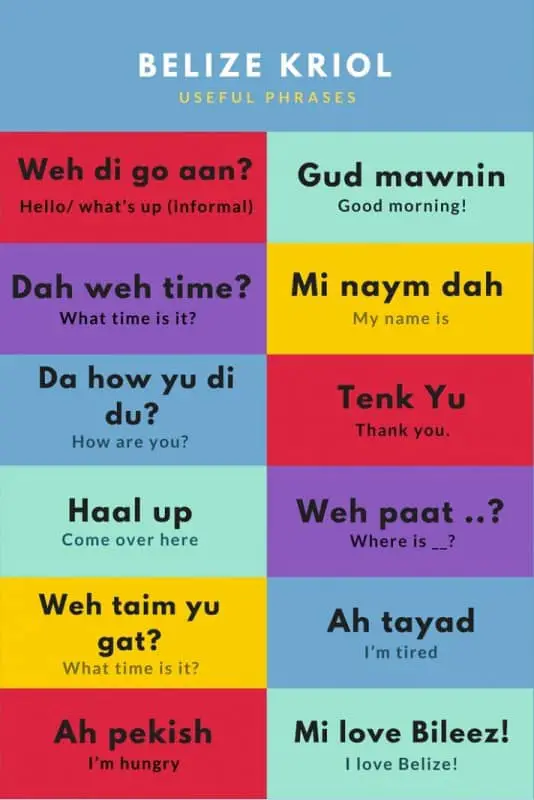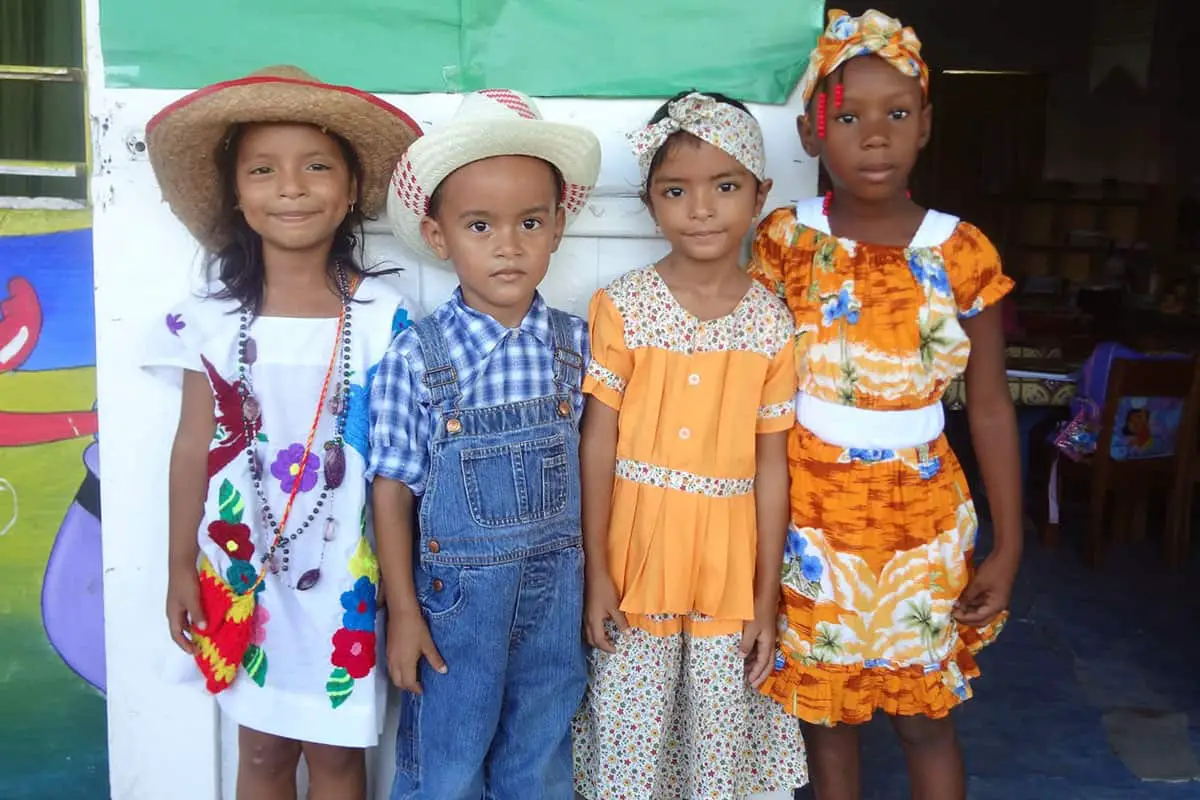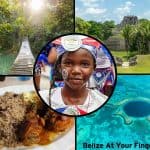Belize is known for its lush jungles, gorgeous rainforests, and pristine beaches. But did you know that the country is also a cultural melting pot where the population can speak as many as seven languages?
English is the official language of Belize. However, the country’s population is mostly multilingual, as almost half of Belizeans speak Kriol (or Belizean Creole), Spanish, and German. A minority of the population also speak Mayan, Garifuna, and Mandarin.
In the rest of this article, we’re going to talk about each of these languages’ history and background, as well as a brief overview of Belizean culture.
Belizean Culture and Impact on Language
Belize is a tiny country located in Central America; however, its rich biodiversity and spectacular natural beauty more than make up for what it lacks in size.
The country boasts of breathtaking beaches (thanks to the Caribbean Sea shorelines) and pristine, government-protected rain forests and jungles.
Its beaches are famous for clear waters and rich marine life. Its rainforests boast of amazing biodiversity like nowhere else in the world. In fact, Belize is home to the largest intact barrier reef in the western hemisphere.
The breathtaking natural beauty and wildlife in Belize have a huge impact on the Belizean way of life, where people have an inherent respect and love for nature. The Belizean lifestyle is also mostly laid back while being fun-loving and religious at the same time.
But the biggest influence on the colorful culture and traditions in the country is its history of Mayan, Chinese, Indian, and Garinagu settlements, conquests and colonization by the Spanish and the Europeans, as well as the traditions and ways of life of the mestizos and creoles.
Today, the population in Belize is considered of multi-racial descent, and the country has the highest percentage of people of African descent in Central America.
The varied cultural influences that shaped Belize into the nation that it is today are most clearly manifest in the many languages that are spoken in the country. The majority of the Belizean population is multilingual, with English as the country’s official language.
Languages Spoken in Belize
A total of seven languages are spoken in Belize, making it a suitable destination for tourists from America, Asia, and Europe. Whether you intend to enjoy the country’s rich marine and terrestrial wildlife and biodiversity or view ruins of ancient civilizations, foreigners will not have a hard time communicating with locals here.
English
The official language in Belize is English. It is the language that Belizeans use for teaching in schools, in government functions, in business transactions, and in any form of formal correspondence. Though not the most commonly spoken in everyday life, English is spoken and understood in all of Belize.
English began to be spoken in the country when the British colonized Belize in 1840. This was when Britain also changed the country’s name to British Honduras, cementing its identity as a British colony.
Aside from their language, the British also introduced the practice of slavery to Belize, bringing with them African slaves. This oppressive practice led to a racial mix between the African slaves and the British settlers–what is now called Creole.
Belize gained independence from the British in 1981, but because of the international prevalence of the language and its importance to business and trade, English remains the country’s official language.
If you get a chance to visit Belize, you might be surprised, though, that while British English is the standard for formal communications and speaking, Belizeans also speak a different type of English called Kriol, sometimes called Belizean Creole.
This variation from the standard British English is considered appropriate in Belize society only in informal settings, such as when talking to friends or at home, and can be considered impolite when used in formal communications.
Additionally, despite English being the country’s official language, it is considered the native tongue of only a few people and is most widely spoken in the Belize District.
You will find that different languages dominate specific parts of Belize, although English is spoken all throughout the country.
Spanish
Before the British came to Belize, it was the Spanish that dominated the country. Spain declared Belize, considered part of what was referred to as the “New World”, a Spanish colony in the 16th century.
Belize was originally explored by the Spanish in search of gold and other minerals, but only a few of them actually settled there.
Contrary to what they expected, there was little gold to be found in the Caribbean territory, so explorers and conquistadors practically left the country alone.
Despite this, some Spanish settlements remained in Belize, creating a huge Spanish influence on culture and language. They were, after all, the first to colonize the country.
It’s no wonder, therefore, that though English is the official language in Belize and the British its most recent colonizer, many people still think of Belize as a Spanish territory.
In fact, if you have been to Belize, you will notice that more Belizeans speak Spanish than English. More than 60% of Belizeans speak Spanish, making it the most common tongue of the Belizean population.
Moreover, approximately 45% of the entire population in Belize speak Spanish as their native tongue. Spanish is also taught in schools.
In more informal settings, a variety of Spanish called “Kitchen Spanish” or “Spanglish” is also spoken. It is a mix between standard English, Belizean Creole, and Spanish and is only used conversationally and not usually in a formal setting or in written correspondence.
Kriol or Belizean Creole
Kriol (or Belizean Creole or Belizean Creole English) is a bridge between standard English and Creole. It has also been described as accented English or a form of English slang.
Kriol first came about with the arrival of African slaves to Belizean territory by British slave owners and traders. These slaves had to learn to understand and speak English to communicate with their owners, and there came about a mix between the Creole language and English.
Belizean Creole, therefore, is an English-based Creole language that is a result of non-native speakers switching from their native tongue to English through practical learning. When spoken, the language is a mixture of Creole and English words that started as a simplified version of English for practical use.
Despite being an English-based language, Kriol relies on a very different grammar structure from that of English. Though it started as a pidgin, it has developed over the years into a complex linguistic system.
Moreover, Kriol is not simply a bridge between Creole and English. It also bears influences from other languages spoken by the slaves who came to Belize, such as Miskito and West African and Bantu languages.
The language is also known as the lingua franca in Belize and is spoken by a majority of the population as a native tongue, no matter their ethnic origin or descent.

Mayan – Kekchi and Mopan
The Mayan civilization is one of the most widely known civilizations in the world. It is believed that the Mayans arrived in Belize in the 1500s, when they settled in the country and pursued a highly advanced agricultural lifestyle.
Testament to the great Mayan civilization are the ancient ruins that can still be found in Belize today, among the most important are the following:
- Caracol
- Lamanai
- Altun Ha
- Xunantunich
- Cahal Pech
- Lubaantun
- El Pilar
- Cerros
- Santa Rita
- Nim Li Punit
These ancient ruins not only prove that Mayan architecture was hundreds of years ahead of its time, but also are breathtaking tourist destinations for those who want to take a trip thousands of years back in history.
It’s important to remember, though, that these majestic ruins were once very important structures to the ancient Mayan communities. They used to be altars, ceremonial or ritual spots, and assembly places for the Mayans and were viewed with respect.
Unfortunately, very little of the Mayan population remains today. Only 6% of the population still speak Kekchi Maya, while a meager 3.8% of the entire Belizean population speaks Mopan Maya. The Kekchi language is considered an endangered language, as it is now spoken only by surviving Mopan Maya communities as a second language.
The indigenous group makes up about 11% of the Belizean population, and majority of them still reside near the sites of these ancient ruins. It is believed that the Mayan communities declined in number due to a combination of political, economic, and societal problems.
Garifuna
Garifuna is the name for the language and culture of the Garinagu communities that reside in Honduras, Guatemala, and Belize. It is an Arawakan language that is also called Black Carib, that has influences from Carib and other African languages. Its vocabulary includes words from French, Spanish, and English.
The Garinagu people are said to have been dispersed from their homelands, some due to shipwrecks, while others due to the slave trade. One of the most common stories about the Garinagu is that of Spanish ships that carried African slaves.
The ships were said to have sunk, with some African slaves surviving and finding refuge in Carib Indian settlements. These Africans became part of these settlements, eventually known as the Black Carib.
What is sure, though, is that the Garinagu communities that left home while the European wars over territory raged, settled in Belize in the 1800s. There, they melded into society and formed part of the ethnic groups that thrive in the country today, bringing their language, as well as their culture and traditions, with them.
One distinct characteristic of the Garifuna language is that it used to have a female and a male variation so that women spoke the language differently from men.
Through the years, however, and owing to the linguistic influence of other ethnic groups, there have been fewer distinctions between male and female versions of the language.
German
About 3% of the total Belizean population speaks German. The small German-speaking community in the country is a recent addition to Belize society and is of the Mennonite faith, a branch of protestant religion that has strict regulations in dress, speech, and other aspects of daily life. They also do not involve themselves in politics.
Moreover, while they originated from Germany, having migrated from the country to Belize in the 1950s, they do not consider themselves German citizens. In fact, they do not adhere to any political affiliation or citizenship, regardless of their residence and culture.
Unlike most Germans, the Mennonite community in Belize speaks an old German dialect that is hardly spoken anywhere else in the world.
One of the main reasons why the community moved to Belize from Germany is so that they would be able to live out their religious beliefs without fear of persecution. Their way of life is extremely conservative and contradicts many of the social norms in society.
To support their community, they work their land and are the biggest producer of poultry and dairy products in Belize.
They are sometimes confused with the Amish groups, which are also highly conservative. However, unlike the Amish, Mennonites are allowed to use vehicles and machines, while the Amish stick to manual labor and do not use motor vehicles.
Mandarin
A minority, about 2%, of the Belizean population consider themselves of Chinese descent and continue to speak Mandarin today. The Chinese community in Belize is descended from Chinese immigrants who were brought to Belize as slaves in the late 1800s.
It is reported that 480 Chinese slaves were brought to do log work in Belize, though some of them were said to have managed to escape. The small Chinese population has established their own community and continues to influence the colorful ethnic traditions prevalent in Belize today.
What languages are commonly spoken by the Mestizo people of Belize?
The mestizo culture in Belize is characterized by a blend of languages. Spanish is commonly spoken among the Mestizo people, as it reflects their heritage and ethnic background. However, English and Belizean Creole are also widely used, highlighting the multicultural and diverse linguistic landscape of the Mestizo community in Belize.
Conclusion
Belize is truly a culturally diverse and colorful nation, with a heritage that spans from America to Asia to Europe. This is most evident in the different languages that are spoken in the country today. After all, language is one of the most important landmarks of culture that, however few continue to speak it, leaves an indelible mark in society.





